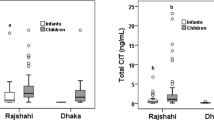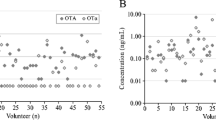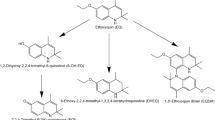Abstract
Ochratoxin A (OTA), a mycotoxin with nephrotoxic and carcinogenic properties, is an important contaminant of food and feed. Analysis of OTA in human biological fluids (blood, urine, or breast milk) has documented frequent exposure to this mycotoxin, yet at quite variable levels in different population groups across the world. Urine is the preferred matrix in biomonitoring since sample collection is non-invasive and better accepted by study participants. As only a small fraction of the ingested OTA is excreted in urine, determination of urinary OTA requires sensitive analytical techniques, and phase-II-metabolites should be also considered as biomarkers of exposure. Yet, data published so far on the presence of OTA-glucuronide/sulfate in human urine have been contradictory. In this study, urines (n = 38) from two groups of breastfed infants (German and Turkish) and from German adults were now analysed for the presence of OTA glucuronides or sulfates by an indirect method, i.e. by comparing the levels of OTA (aglycone) in urines without and after enzymatic hydrolysis with ß-glucuronidase/arylsulfatase. Additionally, ochratoxin A-8-β-glucuronide and open lactone ochratoxin A-8-β-glucuronide were synthesized to serve as reference materials for metabolite analysis. Attempts for definitive confirmation of glucuronides of OTA via direct identification in LC–MS/MS analysis were hampered by the lower ionizability of the conjugates compared to the parent compound. Considerable increases in OTA levels were found after enzymatic hydrolysis in several (not all) urine samples and provide clear evidence for the excretion of OTA-conjugates. The latter observation is of importance, since OTA phase-II-metabolites may escape detection when direct methods are applied for urinary biomarker analysis. In conclusion, enzymatic hydrolysis of urine samples is highly advisable in order to avoid an underestimation of the OTA-exposure.





Similar content being viewed by others
References
Ali N, Blaszkewicz M, Manirujjaman M, Degen GH (2016) Biomonitoring of concurrent exposure to ochratoxin A and citrinin in pregnant women in Bangladesh. Mycotoxin Res:1–10
Angerer J, Ewers U, Wilhelm M (2007) Human biomonitoring: state of the art. Int J Hyg Environ Health 210(3):201–228
Brera C, Caputi R, Miraglia M, Iavicoli I, Salerno A, Carelli G (2002) Exposure assessment to mycotoxins in workplaces: aflatoxins and ochratoxin A occurrence in airborne dusts and human sera. Microchem J 73(1):167–173
Castegnaro M, Maru V, Petkova-Bocharova T, Nikolov I, Bartsch H (1991) Concentrations of ochratoxin A in the urine of endemic nephropathy patients and controls in Bulgaria: lack of detection of 4-hydroxyochratoxin A. IARC Scie Publ (115):165–169
Coffman BL, King CD, Rios GR, Tephly TR (1998) The glucuronidation of opioids, other xenobiotics, and androgens by human UGT2B7Y(268) and UGT2B7H(268). Drug Metab Dispos 26(1):73–77
Coronel M, Marin S, Tarragó M, Cano-Sancho G, Ramos A, Sanchis V (2011a) Ochratoxin A and its metabolite ochratoxin alpha in urine and assessment of the exposure of inhabitants of Lleida, Spain. Food Chem Toxico 49(6):1436–1442
Coronel M, Sanchis V, Ramos A, Marin S (2011b) Ochratoxin A in adult population of Lleida, Spain: presence in blood plasma and consumption in different regions and seasons. Food Chem Toxicol 49(10):2697–2705
Cramer B, Königs M, Humpf H-U (2008) Identification and in vitro cytotoxicity of ochratoxin a degradation products formed during coffee roasting. J Agr Food Chem 56(14):5673–5681
Cramer B, Osteresch B, Muñoz KA, Hillmann H, Sibrowski W, Humpf HU (2015) Biomonitoring using dried blood spots: detection of ochratoxin A and its degradation product 2′R-ochratoxin A in blood from coffee drinkers. Mol Nutr Food Res 59(9):1837–1843
Croom E (2012) Chapter three—metabolism of xenobiotics of human environments. In: Ernest H (ed) Progress in molecular biology and translational science, vol 112. Academic Press, p 31–88
Degen G (2011) Tools for investigating workplace-related risks from mycotoxin exposure. World Mycotoxin J 4(3):315–327
Degen GH (2015) Are we ready to estimate daily ochratoxin A intake based on urinary concentrations? Environ Int. in press. doi:10.1016/j.envint.2015.10.010)
Degen G, Muñoz K, Hengstler J (2013) Occurrence of mycotoxins in breast milk. Handbook of dietary and nutritional aspects of human breast milk. Wageningen Academic Publishers, Wageningen, pp. 813–831
di Giuseppe R, Bertuzzi T, Rossi F et al (2012) Plasma ochratoxin A levels, food consumption, and risk biomarkers of a representative sample of men and women from the Molise region in Italy. Eur J Nutr 51(7):851–860. doi:10.1007/s00394-011-0265-5
Duarte SC, Pena A, Lino CM (2011) Human ochratoxin A biomarkers—from exposure to effect. Crit Rev Toxicol 41(3):187–212
EFSA (2006) Opinion of the scientific panel on contaminants in the food chain on a request from the commission related to ochratoxin A in food. The EFSA Journal 365:56
Ezekiel CN, Warth B, Ogara IM et al (2014) Mycotoxin exposure in rural residents in northern Nigeria: a pilot study using multi-urinary biomarkers. Environ Int 66:138–145
Gareis M, Meussdoerffer F (2000) Dust of grains and malts as a source of ochratoxin a exposure. Mycotoxin Res 16(1):127–130
Gerding J, Cramer B, Humpf HU (2014) Determination of mycotoxin exposure in Germany using an LC-MS/MS multibiomarker approach. Mol Nutr Food Res 58(12):2358–2368. doi:10.1002/mnfr.201400406
Gilbert J, Brereton P, MacDonald S (2001) Assessment of dietary exposure to ochratoxin A in the UK using a duplicate diet approach and analysis of urine and plasma samples. Food Addit Contam 18(12):1088–1093
Gross-Steinmeyer K, Weymann J, Hege HG, Metzler M (2002) Metabolism and lack of DNA reactivity of the mycotoxin ochratoxin a in cultured rat and human primary hepatocytes. J Agr Food Chem 50(4):938–945
Halstensen AS, Nordby K-C, Elen O, Eduard W (2004) Ochratoxin a in grain dust- estimated exposure and relations to agricultural practices in grain production. Ann Agric Environ Med 11(2):245–254
Han Z, Tangni E, Di Mavungu J et al (2013) In vitro glucuronidation of ochratoxin A by rat liver microsomes. Toxins 5(12):2671
Heyndrickx E, Sioen I, Huybrechts B, Callebaut A, De Henauw S, De Saeger S (2015) Human biomonitoring of multiple mycotoxins in the Belgian population: results of the BIOMYCO study. Environ Int 84:82–89. doi:10.1016/j.envint.2015.06.011
Iavicoli I, Brera C, Carelli G, Caputi R, Marinaccio A, Miraglia M (2002) External and internal dose in subjects occupationally exposed to ochratoxin A. Int Arch Occup Envi 75(6):381–386
Jonsyn FE (1999) Intake of aflatoxins and ochratoxins by infants in Sierra Leone: possible effects on the general health of these children. J Nutr Environ Med 9(1):15–22. doi:10.1080/13590849961799
Jonsyn FE, Maxwell SM, Hendrickse RG (1995) Ochratoxin a and aflatoxins in breast milk samples from Sierra Leone. Mycopathologia 131(2):121–126
Jonsyn-Ellis FE (2001) Seasonal variation in exposure frequency and concentration levels of aflatoxins and ochratoxins in urine samples of boys and girls. Mycopathologia 152(1):35–40
Jørgensen K (2005) Occurrence of ochratoxin A in commodities and processed food—a review of EU occurrence data. Food Addit Contam 22(s1):26–30
Klapec T, Šarkanj B, Banjari I, Strelec I (2012) Urinary ochratoxin A and ochratoxin alpha in pregnant women. Food Chem Toxicol 50(12):4487–4492
Koenigs W, Knorr E (1901) Ueber einige derivate des traubenzuckers und der galactose. Ber Dtsch Chem Ges 34(1):957–981
Kühn I, Valenta H, Rohr K (1995) Determination of ochratoxin A in bile of swine by high-performance liquid chromatography. J Chromatogr B Biomed Sci Appl 668(2):333–337
Kuiper-Goodman T (1995) Mycotoxins: risk assessment and legislation. Toxicol Lett 82:853–859
Makun HA, Adeniran AL, Mailafiya SC et al (2013) Natural occurrence of ochratoxin A in some marketed Nigerian foods. Food Control 31(2):566–571. doi:10.1016/j.foodcont.2012.09.043
Malir F, Ostry V, Dofkova M, Roubal T, Dvorak V, Dohnal V (2013) Ochratoxin A levels in blood serum of Czech women in the first trimester of pregnancy and its correspondence with dietary intake of the mycotoxin contaminant. Biomarkers 18(8):673–678. doi:10.3109/1354750x.2013.845609
Märtlbauer E, Usleber E, Dietrich R, Schneider E (2009) Ochratoxin A in human blood serum—retrospective long-term data. Mycotoxin Res 25(4):175–186
Micco C, Miraglia M, Brera C, Corneli S, Ambruzzi A (1995) Evaluation of ochratoxin A level in human milk in Italy. Food Addit Contam 12(3):351–354
Muñoz K (2012) Development of biomonitoring methods for the mycotoxin ochratoxin A and their application to assess infants’ exposure with human milk. Dissertation, Technische Universität Dortmund
Muñoz K, Blaszkewicz M, Campos V, Vega M, Degen GH (2014) Exposure of infants to ochratoxin A with breast milk. Arch Toxicol 88(3):837–846. doi:10.1007/s00204-013-1168-4
Muñoz K, Blaszkewicz M, Degen GH (2010) Simultaneous analysis of ochratoxin A and its major metabolite ochratoxin alpha in plasma and urine for an advanced biomonitoring of the mycotoxin. J Chromatogr B Analyt Technol Biomed Life Sci 878(27):2623–2629. doi:10.1016/j.jchromb.2009.11.044
Muñoz K, Vega M, Rios G, Munoz S, Madariaga R (2006) Preliminary study of ochratoxin A in human plasma in agricultural zones of Chile and its relation to food consumption. Food Chem Toxicol 44(11):1884–1889. doi:10.1016/j.fct.2006.06.008
Njumbe Ediage E, Diana Di Mavungu J, Song S, Sioen I, De Saeger S (2013) Multimycotoxin analysis in urines to assess infant exposure: a case study in Cameroon. Environ Int 57–58:50–59. doi:10.1016/j.envint.2013.04.002
Osteresch B, Cramer B, Humpf H-U (2016) Analysis of ochratoxin A in dried blood spots—correlation between venous and finger-prick blood, the influence of hematocrit and spotted volume. J Chromatogr B 1020:158–164
Pena A, Seifrtova M, Lino C, Silveira I, Solich P (2006) Estimation of ochratoxin A in Portuguese population: new data on the occurrence in human urine by high performance liquid chromatography with fluorescence detection. Food Chem Toxicol 44(9):1449–1454. doi:10.1016/j.fct.2006.04.017
Richard JL, Plattner RD, May J, Liska SL (1999) The occurrence of ochratoxin A in dust collected from a problem household. Mycopathologia 146(2):99–103
Roth A, Chakor K, EkuéCreepy E, Kane A, Roschenthaler R, Dirheimer G (1988) Evidence for an enterohepatic circulation of ochratoxin A in mice. Toxicology 48(3):293–308
Scott PM (2005) Biomarkers of human exposure to ochratoxin A. Food Addit Contam 22(Suppl 1):99–107. doi:10.1080/02652030500410315
Solfrizzo M, Gambacorta L, Lattanzio VT, Powers S, Visconti A (2011) Simultaneous LC–MS/MS determination of aflatoxin M1, ochratoxin A, deoxynivalenol, de-epoxydeoxynivalenol, α and β-zearalenols and fumonisin B1 in urine as a multi-biomarker method to assess exposure to mycotoxins. Anal Bioanal Chem 401(9):2831–2841. doi:10.1007/s00216-011-5354-z
Stazi F, Palmisano G, Turconi M, Clini S, Santagostino M (2004) Accelerated Koenigs-Knorr glucuronidation of a deactivated nitrophenol: unveiling the role of polyamine additive 1,1,4,7,10,10-hexamethyltriethylenetetramine through design of experiments. J Org Chem 69(4):1097–1103. doi:10.1021/jo035285n
Studer-Rohr I, Schlatter J, Dietrich DR (2000) Kinetic parameters and intraindividual fluctuations of ochratoxin A plasma levels in humans. Arch Toxicol 74(9):499–510
Turner PC, White KL, Burley VJ et al (2010) A comparison of deoxynivalenol intake and urinary deoxynivalenol in UK adults. Biomarkers 15(6):553–562
Valenta H, Kühn I, Rohr K (1993) Determination of ochratoxin A in urine and faeces of swine by high-performance liquid chromatography. J Chromatogr B Biomed Sci Appl 613(2):295–302
van Egmond HP (2002) Worldwide regulations for mycotoxins. Adv Exp Med Biol 504:257–269
Vatinno R, Aresta A, Zambonin CG, Palmisano F (2007) Determination of ochratoxin A in human urine by solid-phase microextraction coupled with liquid chromatography-fluorescence detection. J Pharm Biomed Anal 44(4):1014–1018. doi:10.1016/j.jpba.2007.04.008
Wagacha JM, Muthomi JW (2008) Mycotoxin problem in Africa: current status, implications to food safety and health and possible management strategies. Int J Food Microbiol 124(1):1–12. doi:10.1016/j.ijfoodmicro.2008.01.008
Walker R (2002) Risk assessment of ochratoxin: current views of the European Scientific Committee on Food, the JECFA and the Codex Committee on Food Additives and Contaminants Mycotoxins and Food Safety. Springer, p:249–255
Warth B, Sulyok M, Fruhmann P et al (2012) Assessment of human deoxynivalenol exposure using an LC-MS/MS based biomarker method. Toxicol Lett 211(1):85–90. doi:10.1016/j.toxlet.2012.02.023
Xiao H, Madhyastha S, Marquardt RR et al (1996) Toxicity of ochratoxin A, its opened lactone form and several of its analogs: structure–activity relationships. Toxicol Appl Pharmacol 137(2):182–192
Zemplén G, Pacsu E (1929) Über die Verseifung acetylierter Zucker und verwandter Substanzen. Ber Dtsch Chem Ges (A and B Series) 62(6):1613–1614
Acknowledgment
The authors want to thank Iris Glaeser (IfADo) for their technical help and Dr. Meinolf Blaszkewicz for his comments on an earlier version of this manuscript. Finally, we want to thank DAAD and CONICYT for their support.
Author information
Authors and Affiliations
Corresponding author
Ethics declarations
Conflict of interest
None
Source of funding
This study was funded by Leibniz Research Centre for Working Environment and Human Factors (IfADo).
Electronic supplementary material
ESM 1
(DOCX 55 kb)
Chromatograms of the MRM-transitions of the reference solutions for open lactone ochratoxin A-8-O-β-glucuronide and ochratoxin A-8-O-β-glucuronide as well as product ion spectra of both compounds are provided.
Rights and permissions
About this article
Cite this article
Muñoz, K., Cramer, B., Dopstadt, J. et al. Evidence of ochratoxin A conjugates in urine samples from infants and adults. Mycotoxin Res 33, 39–47 (2017). https://doi.org/10.1007/s12550-016-0261-y
Received:
Revised:
Accepted:
Published:
Issue Date:
DOI: https://doi.org/10.1007/s12550-016-0261-y




